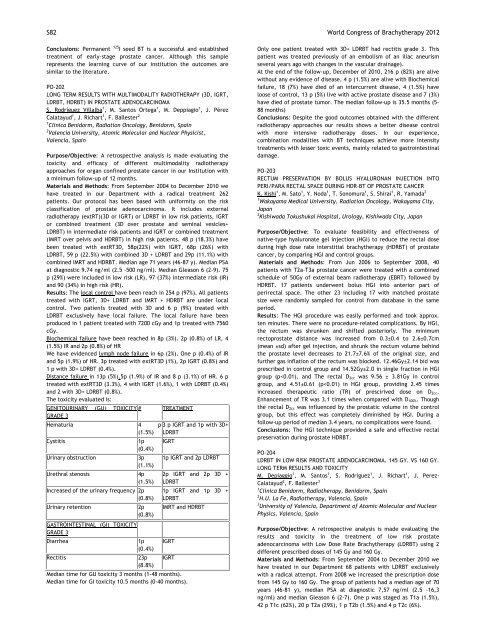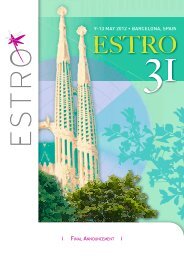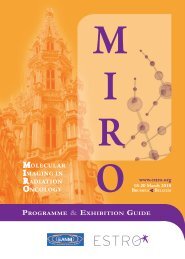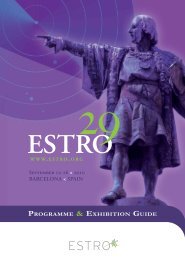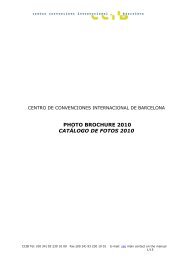World Congress of Brachytherapy 10-12 May, 2012 - Estro-events.org
World Congress of Brachytherapy 10-12 May, 2012 - Estro-events.org
World Congress of Brachytherapy 10-12 May, 2012 - Estro-events.org
You also want an ePaper? Increase the reach of your titles
YUMPU automatically turns print PDFs into web optimized ePapers that Google loves.
S82 <strong>World</strong> <strong>Congress</strong> <strong>of</strong> <strong>Brachytherapy</strong> 20<strong>12</strong><br />
: Permanent <strong>12</strong>5 I seed BT is a successful and established<br />
treatment <strong>of</strong> earlystage prostate cancer. Although this sample<br />
represents the learning curve <strong>of</strong> our institution the outcomes are<br />
similar to the literature.<br />
PO202<br />
LONG TERM RESULTS WITH MULTIMODALITY RADIOTHERAPY (3D, IGRT,<br />
LDRBT, HDRBT) IN PROSTATE ADENOCARCINOMA<br />
S. Rodríguez Villalba 1 , M. Santos Ortega 1 , M. Deppiagio 1 , J. Pérez<br />
Calatayud 1 , J. Richart 1 , F. Ballester 2<br />
1<br />
Clinica Benidorm, Radiation Oncology, Benidorm, Spain<br />
2<br />
Valencia University, Atomic Molecular and Nuclear Physicist,<br />
Valencia, Spain<br />
: A retrospective analysis is made evaluating the<br />
toxicity and efficacy <strong>of</strong> different multimodality radiotherapy<br />
approaches for <strong>org</strong>an confined prostate cancer in our Institution with<br />
a minimum followup <strong>of</strong> <strong>12</strong> months.<br />
: From September 2004 to December 20<strong>10</strong> we<br />
have treated in our Department with a radical treatment 262<br />
patients. Our protocol has been based with uniformity on the risk<br />
classification <strong>of</strong> prostate adenocarcinoma. It includes external<br />
radiotherapy (extRT)(3D or IGRT) or LDRBT in low risk patients, IGRT<br />
or combined treatment (3D over prostate and seminal vesicles+<br />
LDRBT) in intermediate risk patients and IGRT or combined treatment<br />
(IMRT over pelvis and HDRBT) in high risk patients. 48 p (18.3%) have<br />
been treated with extRT3D, 58p(22%) with IGRT, 68p (26%) with<br />
LDRBT, 59 p (22.5%) with combined 3D + LDRBT and 29p (11.1%) with<br />
combined IMRT and HDRBT. Median age 71 years (4687 y). Median PSA<br />
at diagnostic 9.74 ng/ml (2.5 500 ng/ml). Median Gleason 6 (29). 75<br />
p (29%) were included in low risk (LR), 97 (37%) intermediate risk (IR)<br />
and 90 (34%) in high risk (HR).<br />
: The local control have been reach in 254 p (97%). All patients<br />
treated with IGRT, 3D+ LDRBT and IMRT + HDRBT are under local<br />
control. Two patients treated with 3D and 6 p (9%) treated with<br />
LDRBT exclusively have local failure. The local failure have been<br />
produced in 1 patient treated with 7200 cGy and 1p treated with 7560<br />
cGy.<br />
Biochemical failure have been reached in 8p (3%). 2p (0.8%) <strong>of</strong> LR, 4<br />
(1.5%) IR and 2p (0.8%) <strong>of</strong> HR<br />
We have evidenced lymph node failure in 6p (2%). One p (0.4%) <strong>of</strong> IR<br />
and 5p (1.9%) <strong>of</strong> HR. 3p treated with extRT3D (1%), 2p IGRT (0.8%) and<br />
1 p with 3D+ LDRBT (0.4%).<br />
Distance failure in 13p (5%).5p (1.9%) <strong>of</strong> IR and 8 p (3.1%) <strong>of</strong> HR. 6 p<br />
treated with extRT3D (3.3%), 4 with IGRT (1.6%), 1 with LDRBT (0.4%)<br />
and 2 with 3D+ LDRBT (0.8%).<br />
The toxicity evaluated is:<br />
GENITOURINARY (GU) TOXICITY # TREATMENT<br />
GRADE 3<br />
Hematuria 4 p 3 p IGRT and 1p with 3D+<br />
(1.5%) LDRBT<br />
Cystitis 1p IGRT<br />
(0.4%)<br />
Urinary obstruction 3p 1p IGRT and 2p LDRBT<br />
(1.1%)<br />
Urethral stenosis 4p<br />
(1.5%)<br />
Increased <strong>of</strong> the urinary frequency 2p<br />
(0.8%)<br />
Urinary retention 2p<br />
(0.8%)<br />
GASTROINTESTINAL (GI) TOXICITY<br />
GRADE 3<br />
Diarrhea 1p<br />
(0.4%)<br />
Rectitis 23p<br />
(8.8%)<br />
2p IGRT and 2p 3D +<br />
LDRBT<br />
1p IGRT and 1p 3D +<br />
LDRBT<br />
IMRT and HDRBT<br />
IGRT<br />
IGRT<br />
Median time for GU toxicity 3 months (148 months).<br />
Median time for GI toxicity <strong>10</strong>.5 months (040 months).<br />
Only one patient treated with 3D+ LDRBT had rectitis grade 3. This<br />
patient was treated previously <strong>of</strong> an embolism <strong>of</strong> an iliac aneurism<br />
several years ago with changes in the vascular drainage).<br />
At the end <strong>of</strong> the followup, December <strong>of</strong> 20<strong>10</strong>, 216 p (82%) are alive<br />
without any evidence <strong>of</strong> disease, 4 p (1.5%) are alive with Biochemical<br />
failure, 18 (7%) have died <strong>of</strong> an intercurrent disease, 4 (1.5%) have<br />
loose <strong>of</strong> control, 13 p (5%) live with active prostate disease and 7 (3%)<br />
have died <strong>of</strong> prostate tumor. The median followup is 35.5 months (5<br />
88 months)<br />
: Despite the good outcomes obtained with the different<br />
radiotherapy approaches our results shows a better disease control<br />
with more intensive radiotherapy doses. In our experience,<br />
combination modalities with BT techniques achieve more intensity<br />
treatments with lesser toxic <strong>events</strong>, mainly related to gastrointestinal<br />
damage.<br />
PO203<br />
RECTUM PRESERVATION BY BOLUS HYALURONAN INJECTION INTO<br />
PERI/PARA RECTAL SPACE DURING HDRBT OF PROSTATE CANCER<br />
K. Kishi 1 , M. Sato 1 , Y. Noda 1 , T. Sonomura 1 , S. Shirai 1 , R. Yamada 2<br />
1<br />
Wakayama Medical University, Radiation Oncology, Wakayama City,<br />
Japan<br />
2<br />
Kishiwada Tokushukai Hospital, Urology, Kishiwada City, Japan<br />
: To evaluate feasibility and effectiveness <strong>of</strong><br />
nativetype hyaluronate gel injection (HGI) to reduce the rectal dose<br />
during high dose rate interstitial brachytherapy (HDRBT) <strong>of</strong> prostate<br />
cancer, by comparing HGI and control groups.<br />
: From Jun 2006 to September 2008, 40<br />
patients with T2aT3a prostate cancer were treated with a combined<br />
schedule <strong>of</strong> 50Gy <strong>of</strong> external beam radiotherapy (EBRT) followed by<br />
HDRBT. 17 patients underwent bolus HGI into anterior part <strong>of</strong><br />
perirectal space. The other 23 including 17 with matched prostate<br />
size were randomly sampled for control from database in the same<br />
period.<br />
: The HGI procedure was easily performed and took approx.<br />
ten minutes. There were no procedurerelated complications. By HGI,<br />
the rectum was shrunken and shifted posteriorly. The minimum<br />
rectoprostate distance was increased from 0.3±0.4 to 2.6±0.7cm<br />
(mean ±sd) after gel injection, and shrunk the rectum volume behind<br />
the prostate level decreases to 21.7±7.6% <strong>of</strong> the original size, and<br />
further gas inflation <strong>of</strong> the rectum was blocked. <strong>12</strong>.46Gy±2.14 bid was<br />
prescribed in control group and 14.52Gy±2.0 in single fraction in HGI<br />
group (p


